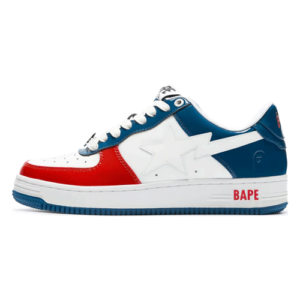In the vibrant world of streetwear, where fashion and identity collide, few sneakers have managed to leave a lasting impression quite like the BAPESTA. Emerging from the heart of Tokyo’s fashion scene, the BAPESTA is more than just footwear; it is a cultural artifact. Launched by A Bathing Ape (BAPE), a Japanese brand founded by Nigo in 1993, the BAPESTA sneaker has grown into a symbol of global street style, youth rebellion, and creative expression. With its distinctive look and rich history, the BAPESTA continues to captivate sneakerheads and fashion enthusiasts around the world.
The Origins of BAPESTA
The BAPESTA first hit the streets in the early 2000s, when BAPE decided to enter the sneaker market. The shoe instantly grabbed attention due to its striking resemblance to the Nike Air Force 1. However, BAPESTA added a twist—an iconic shooting star logo called the “STA” replacing Nike’s Swoosh, and a variety of vibrant, glossy patent leather colorways that set it apart. Rather than copying, Nigo intended this to be a reinterpretation—a remix of Western sneaker culture through a Japanese lens.
Nigo’s deep interest in American pop culture, hip-hop, and vintage fashion fueled the design of BAPESTA. This cultural crossover became the sneaker’s identity, appealing to a global audience that embraced the fusion of East and West.
Pop Culture and Celebrity Influence
The BAPESTA’s popularity skyrocketed in the early 2000s due to its adoption by influential celebrities and musicians. Hip-hop artists like Pharrell Williams, Kanye West, Soulja Boy, and Lil Wayne were frequently seen sporting the colorful kicks. The connection between hip-hop and streetwear has always been strong, and BAPESTA became a canvas for self-expression within the rap community. This endorsement gave the sneaker its cult status and made it a must-have item in the wardrobes of style-conscious youth.
Collaborations with artists and brands further elevated BAPESTA’s fame. Limited edition drops with icons like Pharrell and Kanye, or with brands such as Marvel and SpongeBob SquarePants, brought fresh designs and massive hype. Each release added a layer of storytelling and collectibility to the BAPESTA legacy.
Design Aesthetics That Define BAPESTA
One of the defining features of BAPESTA is its bold design philosophy. Unlike minimalist sneaker trends, BAPESTAs embrace loud, flashy, and unapologetically vibrant color schemes. The glossy patent leather, combined with high-saturation colors and camo prints, makes the sneakers instantly recognizable. The use of the star logo, often outlined and exaggerated, also gives the shoes a signature visual identity.
Another unique aspect is how BAPE incorporates playful and pop culture-inspired graphics. Whether it’s Baby Milo, shark motifs, or cartoon-themed editions, BAPESTA thrives on a youthful, fun aesthetic that resonates with the energy of street culture.
Global Influence and Cultural Impact
Though born in Japan, BAPESTA quickly broke through international boundaries. By the mid-2000s, the sneaker was influencing fashion trends in New York, London, and Paris. BAPE stores in major cities became hotspots for urban fashionistas and collectors eager to get their hands on the latest drop.
The influence of BAPESTA extended beyond just footwear. It inspired an entire movement within streetwear where exclusivity, individuality, and cultural storytelling became more important than traditional luxury branding. In many ways, BAPESTA helped pioneer the modern hype-driven model of fashion releases, where limited editions and surprise collaborations drive demand.
Streetwear forums, blogs, and social media platforms like Instagram also helped fuel the sneaker’s growth. Online communities became places for fans to showcase collections, review new releases, and trade rare pairs. BAPESTA became more than a shoe—it became part of an identity, a status symbol in the streetwear community.
The Resurgence of BAPESTA in Modern Fashion
While BAPESTA enjoyed peak popularity in the mid-2000s, its influence never truly faded. In recent years, the sneaker has experienced a powerful resurgence. The revival of Y2K fashion, nostalgia-driven trends, and the growing appreciation for early 2000s streetwear have brought BAPESTA back into the limelight.
BAPE has also revitalized the sneaker line by re-releasing classic colorways and introducing new versions with updated materials and designs. Modern collaborations with artists like Kid Cudi and brands like Coach have breathed new life into the silhouette. These partnerships introduce BAPESTA to a new generation while keeping older fans engaged.
The rise of reselling platforms has also contributed to the renewed hype. Rare and vintage BAPESTAs fetch high prices on the secondary market, showcasing their continued demand and collectability. For many, owning a pair is not just about fashion—it’s about being part of a legacy.
BAPESTA’s Place in Sneaker History
The BAPESTA holds a unique place in sneaker history. It’s not just a derivative of a famous silhouette; it’s a reimagination that broke all the rules. Its success lies in its boldness, its embrace of pop culture, and its refusal to follow trends. Instead, it created them. The sneaker helped bridge Japanese street fashion with Western hip-hop culture, setting the stage for today’s globally interconnected streetwear scene.
Unlike many other sneakers, BAPESTA carries a sense of exclusivity and individuality. Each design drop tells a story, makes a statement, and adds a new chapter to its legacy. Collectors value not just the shoe, but the era and culture it represents.
Conclusion: The Future of BAPESTA
As fashion continues to evolve, the BAPESTA remains a timeless piece of streetwear history. Its loud style, cultural roots, and influential collaborations have ensured its place as a cornerstone in the world of sneakers. With each new generation discovering the brand, BAPESTA continues to inspire creativity, individuality, and rebellion against the ordinary.







0 Comments